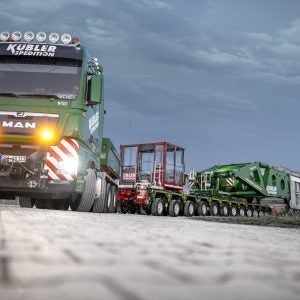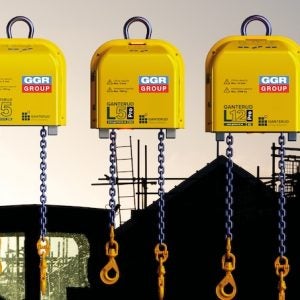To sell almost any type of machine in Europe, a manufacturer must comply with the community’s machinery directive. Individual classes of machines must comply with specific standards, known by their EN number. Recently, the standard covering mobile cranes, EN 13000, has been subject to fierce debate, both within Europe and between Europe and the US.
The latest revision of the standard, EN 13000:2009, places restrictions on the ability of the operator to bridge the crane’s rated capacity limiter (RCL). At the initial prompting of the German health and safety regulator, the ability to fully override the RCL was moved out of the operator’s reach, to a switch in a locked box outside the cab. Additionally a data logger will become mandatory.
From the cab, the operator is able to operate the crane over its rated capacity, up to 110% of the rated load, but only at 15% of maximum speed to get out of dead lock situations. A control in the cab offers three modes of operation: set up, when no RCL is used; normal operation, when the crane works within the limits of the RCL; and this limited override, where the crane operates at 110% of capacity but 15% of maximum speed.
Reaching agreement on this approach took considerable work by WGP1, the working group of industry experts put together by the European standards body, the CEN, to revise EN 13000. The proposed revision was formally, EN 13000:2009, was announced in April. Since then, it has been translated and distributed to member states for agreement.
WGP1 member and Liebherr design engineer, Hans-Dieter Willim briefed Cranes Today on the progress of the revision. One problem in the adoption process came, Willim said, when a heading number was missed from the English translation of the standard. Another came when the German word ”Meisterschalter”, was translated into English as ‘master switch’ but into French as a phrase that means something closer to ‘main switch’.
This latter problem with the translation of the amendment of the standard was fixed when the phrase ‘control lever’ was used in the English translation. The current plan for the standard is that it will be agreed by all EU member states in time to come into force in 2010. The French are, however, still holding out the possibility of asking for more time to consider the revision, which could delay adoption . While there is a legal possibility that an EU member state could veto the amendment (which requires approval from members), all of the experts Cranes Today has spoken to say they expect EN 13000:2009 to be adopted next year.
The disagreement over the standard does not end there, however. As Willim puts it, there is a fundamental difference in philosophy between the US and EU. In the US, the industry largely holds that the operator should have ultimate control of his machine: systems like RCLs are viewed by the US regulator OSHA only as operator assistance devices, not limiters. In the EU, the approach of regulators is that most accidents are the result of human error, not machine faults: the machine should override dangerous operator decisions, rather than the operator overriding the crane’s safety systems.
This poses a problem for manufacturers who want to build cranes for both markets, and for the trade in second hand European cranes in the US. The US rental association, the SC&RA, has campaigned heavily against the amendment. No transatlantic agreement was achievable in time for EN 13000:2009. However, a new revision to the standard will be considered in a couple of years time, and this time a policy everyone in the industry can support looks more likely.
Last month, members of the SC&RA, the EU rental body ESTA and the EU manufacturers body the FEM met to discuss a shared approach to a future solution to override the RCL which will satisfy the European and American requirements . The solution they came up with will allow the operator in an emergency case to bridge the RCL without any speed reduction., but will make his employer responsible for monitoring when the RCL has been bypassed.
In the proposed system, a single use emergency button will be available in the cab. When the operator hits the button, he will be able to operate the crane without the RCL at maximum speed, for up to half an hour. Willim explains that this will give operators the chance to rescue their crane from certain very rare emergencies, which they may not be able to do under EN 13000:2009. For example, if the ground beneath the crane’s outriggers collapses while the load is a short distance from the ground, a quick thinking operator may be able to boom down fast enough to stop the crane tipping. A similar emergency override could save a crane that is suddenly overloaded to more than 110% of the rated capacity when supporting a beam much heavier than calculated that is being cut from a building, or in the event of a failure of one crane in a multi-crane lift transferring additional loads to the others exceeding 110% of the rated capacity of those cranes.
These sort of emergencies are very rare if the lift is planned properly. At the same time, many in the European industry want to make sure that operators aren’t pushed by clients to routinely override their RCL. To prevent this, the operator will only be able to use the emergency button once. Once it has been used, he will need to have an authorised person, normally the crane’s owner, which inserts a separate key in the key hole, located outside the cab to reset the emergency button. Until this is done, the crane must not be operated as the emergency button will be out of function in case of a second emergency.
This approach has won the support of the SC&RA, ESTA, and the FEM, essentially 90% of the crane industry on both sides of the Atlantic, Willim says. However, the industry experts have not yet managed to persuade the German regulator that it is a reasonable approach to take. Until EN 13000:2009 is put into place next year, Willim adds, no one is pushing regulators in other EU member states to look closely at the new proposal.






